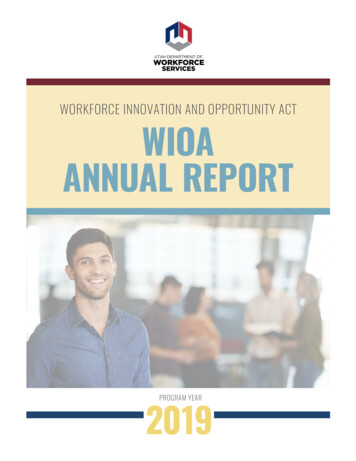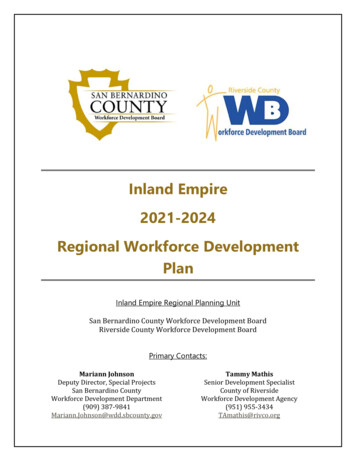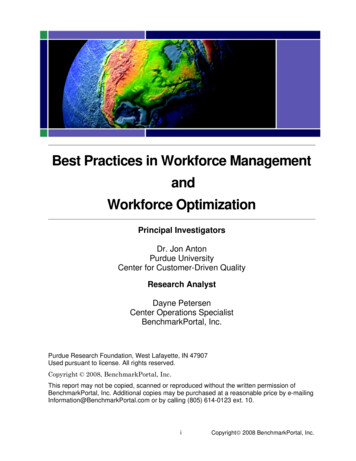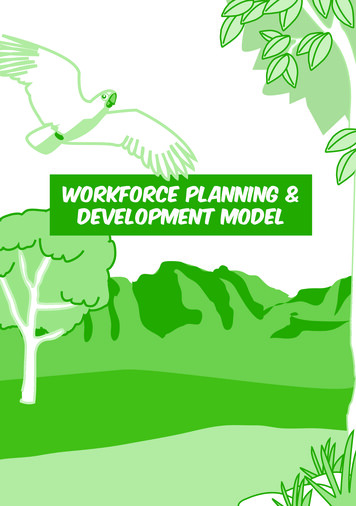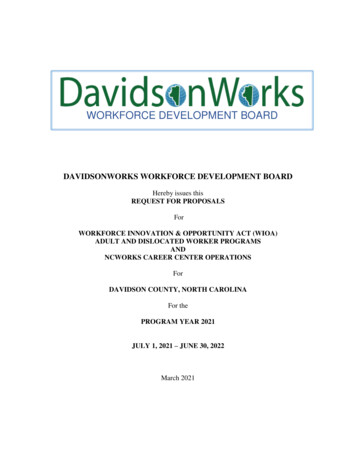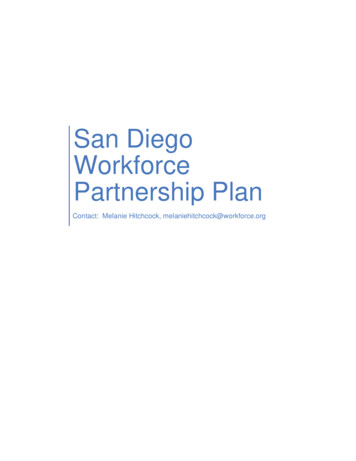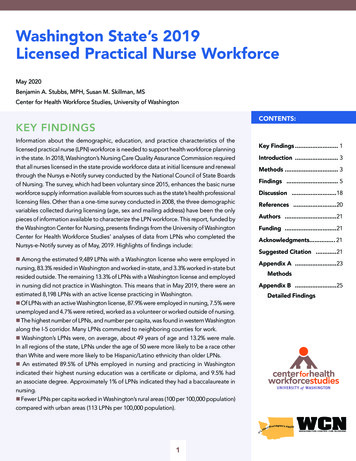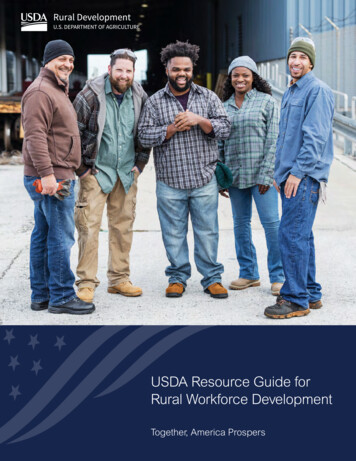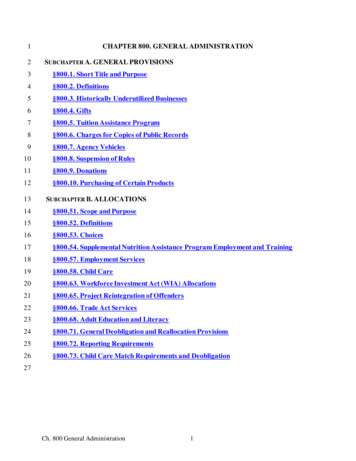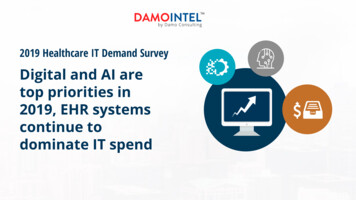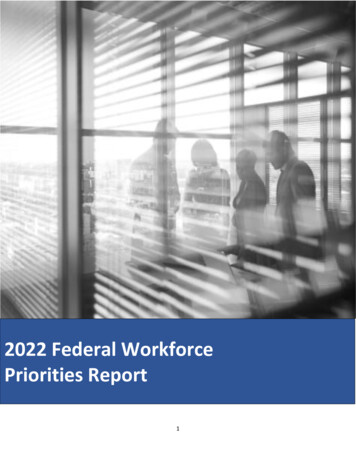
Transcription
2022 Federal WorkforcePriorities Report1
Table of ContentsPreface . 3Executive Summary . 5Supporting Research and Analysis . 6Priorities . 7Priorities in the Context of People: Building, Maintaining, and Empowering a 21st Century Workforce 9Priorities in the Context of Platforms and Processes: Utilizing Data, Foresight, and Technology toOptimize Performance . 10Priorities Graphic . 12Priorities Overview . 13Primary Priorities. 14Priority 1: Leveraging Technology & Modernizing IT Processes . 14Priority 2: Recruitment, Succession Planning, & Knowledge Transfer . 15Priority 3: Enhancing Employee Experience, Fostering Employee Well-Being, and Building aDiverse and Inclusive Workforce . 18Priority 4: Fostering an Agile Organization and the Growth Mindset . 21Enabling Priorities . 22Priority 5: Enhancing Customer Experience . 22Priority 6: Leveraging Data as a Strategic Asset . 23Priority 7: Preparedness and Resilience . 25Priority 8: Developing an Agency Foresight Capability . 26Priorities Crosswalk . 30Open Opportunities . 32Conclusion . 32References . 332
PrefaceAgencies are working on a host of federal workforce priorities, which are set by numerousissuances from the Administration, including the President’s Management Agenda (PMA), thePresident’s budget, and numerous executive orders and regulatory requirements. Therequirements set by these various authorities are numerous, as the attention on rebuilding theFederal workforce is at an all-time high. The energy across the Federal government is palpable,and we have a rare opportunity, as an HR community, to make major headway on the challengeswe have faced for years if not decades.The Federal Workforce Priorities Report comes at an interesting time. With no shortage ofattention on the Federal workforce, it is important to remember the reason that we issue aquadrennial Report and what its purpose is. Effective April 11, 2017, Title 5, Code of FederalRegulations, Part 250, Subpart B, Strategic Human Capital Management required the Office ofPersonnel Management (OPM) to issue the quadrennial Federal Workforce Priorities Report(FWPR or the report). The report communicates key governmentwide human capital prioritiesintended to inform agency strategic and human capital planning. Agencies, defined as thoseincluded in the Chief Financial Officers Act of 1990 and subsequently the Chief Human CapitalOfficers Act of 2002, are required to align their human capital management strategies to supportthe Federal Workforce Priorities Report, as demonstrated in Human Capital Operating Plans(HCOPs). The human capital regulation governing this report requires those agencies to supportand incorporate the report priorities within their HCOPs.OPM established the report in regulation in response to the first recommendation in theGovernment Accountability Office (GAO) report, “Human Capital: Strategies to Help AgenciesMeet Their Missions in an Era of Highly Constrained Resources” (GAO-14-168). Therein, GAOrecommended that OPM strengthen coordination and leadership of government-wide humancapital issues. One of two key supporting actions was the development of a government-widehuman capital strategic plan. Building upon this idea, OPM committed to developing a reportthat establishes governmentwide human capital priorities based upon current and emergingworkforce challenges. The report, however, is not intended to serve as a plan that obligates thehuman capital community to specific actions, time frames, and measures of success. Rather, thePresident’s Management Agenda and Cross-Agency Priority Goals create a process forestablishing such governmentwide requirements, and when developing human capital goals, thereport may be considered as a source for useful insights and strategies.Agencies are required to engage in activities to support the priorities, while maintaining flexibilityand autonomy in how they do so. HCOPs should document supporting agency efforts, includingtime frames and performance measures. Evaluation initiatives, such as HRStat, IndependentAudits, and Human Capital Reviews, are intended to help monitor progress, assess effectiveness,and refine strategies. The HCOPs, in turn, may be updated annually, as needed and determined3
by each agency. Therefore, the priorities should be implemented by agencies within variousstages of the human capital management cycle.We understand that incorporating a new set of Federal workforce priorities would be a challengefor agencies in light of all of the other activity, mentioned above, on which they are alreadyengaged. Accordingly, we worked with agencies to make sure that the work they do under thisreport aligns with and compliments the other work they are doing on the Federal workforce,including through the PMA. We anticipate it will be seamless for agencies to build in thesepriorities to strengthen the work they are doing on already existing workforce initiatives.4
Executive SummaryComprised of fifteen different departments and numerous bureaus, agencies, and offices, theFederal Government is responsible for promoting conditions that create prosperity and assurethe safety of all Americans. The day-to-day operations are conducted by professional, dedicated,and hard-working civil servants who play a critical role in managing the complex processesrequired to steward government and execute each unique mission. In a time of unprecedentedtechnological advances and global change, Federal leaders, managers, and front-line employeesmust not only be aware of the changes to the work, workforce, and workspace, but must also beable to identify weak signals, anticipate trends, and plan for the inevitable changes. The globalCoronavirus Disease 2019 (COVID-19) pandemic only amplified the importance of sound humancapital planning, as agencies need to be equipped to react to emerging needs and newrequirements, sometimes with little to no advance warning at all. Anticipatory workforcemanagement must become the hallmark of leaders at all levels, as well as every civil servant whodesires to assist in the vitally important work done by the Federal Government. This report,building on the 2018 Federal Workforce Priorities Report, continues to highlight opportunitiesand challenges within the human capital space, identify critical priorities for the future Federalworkforce, and provide recommendations for strategic decision-makers and employees.5
Supporting Research and AnalysisThe Office of Personnel Management (OPM) began conducting research in 2019 to identifycurrent and future workforce risks, challenges, and opportunities. Using the STEEP (Social,Technological, Environmental, Economic, and Political) environmental scanning framework, OPMgathered a significant amount of information on both the internal state of the FederalGovernment and the external environment. When COVID-19 began impacting the workplace, theresearch team expanded its research on preparedness and resilience as a future priority.The following is a brief list of document repositories and legislation the research team analyzedwhen formulating the support for each priority. This is not an all-inclusive list. Additionalreferences supporting the priorities are listed at the conclusion of this report. The President’s Annual Budget for Fiscal Year 2021Budget of the U.S. Government - Fiscal year 2022The President’s Management AgendaThe Biden- Harris Administration Immediate PrioritiesOffice of Management and Budget Launches Biden- Harris Management Agenda VisionThe Foundations for Evidence-Based Policymaking Act of 2018Federal Employee Viewpoint SurveyIT Spending Dashboard & Makor Projects ListAgency Strategic PlansOffice of E-Government & Information TechnologyGovernment-wide Strategic Plan to Advance Diversity, Equity, Inclusion, and Accessibilityin the Federal WorkforceInspector General Management ChallengesGovernment Accountability Office Reports and High-Risk ListsCongressional ReportsHuman Capital Operating PlansHuman Capital reviewsTo identify priorities, OPM reviewed a myriad of documents using a variety of methods, includingthe use of text mining programs that identified key words, themes, and phrases. Thesedocuments allowed OPM to understand the various challenges faced by agencies since thepublication of the previous FWPR and what new challenges lay beyond the horizon.6
PrioritiesThe research led OPM to focus on three areas for the 2021 FWPR: People, Platforms, andProcesses. As the COVID-19 pandemic unfolded in 2020, OPM recognized that these were vitalfocus areas for any post-pandemic government workforce and workplace. In addition,Administration priorities will clearly focus on the elimination of systemic racism, pandemicresponse and eradication, diversity, equity, inclusion, and accessibility, economic stability,climate change, national security, recruitment of a world class workforce, and the strengtheningthe civil service so it works for all Americans. Understanding that within any agency, people useplatforms to complete processes that facilitate effective management and achieve missionsuccess, we believe these three pillars are critical to running an efficient and effectivegovernment enterprise. We also recognize that the world continues to rapidly change and evolve.COVID-19 is still impacting daily life for every American and though the economy continues torebound it is still recovering from the pandemic. These priorities, grounded in rigorous research,are a foundation for the future and should assist agencies in long-term strategic planning forfuture success.Based upon the research and findings, OPM identified eight priorities in areas that, whenaddressed, will spur productivity and organizational success, and align with Administrationpriorities. The eight priorities are listed below: Recruitment, Succession Planning, & Knowledge TransferEnhancing Employee Experience, Fostering Employee Well-Being, and Building a Diverseand Inclusive WorkforceFostering an Agile Organization and the Growth MindsetEnhancing Customer ExperiencePreparedness & ResilienceLeveraging Data as a Strategic AssetLeveraging Technology and Modernizing IT ProcessesDeveloping an Agency Foresight CapabilityIt is also vitally important to recognize the successes and efforts agencies have achieved with thecurrent workforce priorities, celebrate those successes, and pass on the lessons learned so otheragencies may achieve similar successes. In order to ensure that agency efforts based on theprevious report can continue and expand, the new priorities identified in this report align withthe previous priorities from the 2018 Federal Workforce Priorities Report.The priorities are organized under the rubric: People, Platforms, and Processes. This organizationstrategy was initially designed by OPM but in order to gather agency feedback and ensure thatthe priorities resonated with the HR community and senior leadership within the government,several additional focus groups were convened. In October 2021, the focus groups, comprised ofChief Human Capital Officers, Deputy Chief Human Capital Officers, and Human Capital experts7
were convened to discuss the notional priorities. While it was clear that all eight prioritiesresonated with the assembled participants, four of the priorities rose to the top. Consideringthese findings, OPM decided to maintain the People, Platforms, and Processes rubric but add anadditional layer of delineation. Within the overall organization, four of the priorities are alsoassigned the label of Primary and the remaining four priorities are assigned the label of Enabling.Agencies are required to work on two of the primary priorities and leverage the enablingpriorities to the maximum extent possible to support their efforts.The enabling priorities will have a direct impact on successful implementation of the primarypriorities. In addition, the enabling priorities are critical for designing visionary strategies,identifying metrics for success, and measuring progress over the next four years. The enablingpriorities are foundational for future success and critical to sound Human Capital Management.Agencies should focus their efforts on two primary priorities but recognize that they will needto use the concepts espoused by the enabling priorities to maximize their success.8
Federal Workforce Priorities ConcurrenceCommunityof PracticeLeveraging Technology & Modernizing IT Processes87%Recruitment, Succession Planning, & Knowledge87%TransferEnhancing Employee Experience, FosteringEmployee Well-Being, and Building a Diverse and94%Inclusive WorkforceFostering an Agile Organization and the Growth86%MindsetEnhancing Customer Experience78%Leveraging Data as a Strategic Asset83%Preparedness and Resilience58%Developing an Agency Foresight Capability62%Chief Human CapitalOfficer Focus Group100%95%84%69%62%61%53%37%Priorities in the Context of People: Building,Maintaining, and Empowering a 21st CenturyWorkforceAgencies can no longer afford to react to workforce and technological changes when they occur.While agencies continue to systematically identify the required workforce skills, roles, andcompetencies, they should also anticipate changes and plan early to successfully address futureopportunities and challenges. This includes using data as a strategic asset to determineappropriate personnel costs; streamlining policy creation and adoption; recruiting a diverse andhighly skilled workforce; and reviewing and revising, when appropriate, organizational design andposition structures, especially when technology and external forces impact legacy positions andoccupations. It is critical to build a culture throughout government that is sufficiently agile torespond to evolving demands when planning and implementing workforce-reshaping activities.Agencies understand the workforce is changing, and the Federal Government must change withit. All agencies must recommit to branding their work to ensure that they are doing their best toattract the next generation of government employees and providing them the necessary careerpath to retain that talent. In addition, it should be made clear that every Federal job is vital tothe success of the American republic and that civil service is critical to maintaining our democracyand ensuring the vulnerable and underserved populations are not neglected. Every Federal job isan important job!Diversity, equity, inclusion, and accessibility (DEIA) lies at the heart of civil service. Within theFederal workplace, all are welcomed and empowered because, through DEIA, the workforce isstronger, smarter, and more efficient and effective. The new PMA internalizes these vital9
concepts and provides pillars that can assist agencies in implementing the priorities in this report.Agencies should: (1) attract and hire the most qualified employees, who reflect the diversity ofour country, in the right roles across the Federal Government; (2) make every Federal job a goodjob, where all employees are engaged, empowered, developed, and included throughout theircareers; (3) reimagine and build a roadmap to the future of Federal work informed by learningsfrom the pandemic and nationwide workforce and workplace trends and; (4) build theinfrastructure required to sustain the Federal Government as a model employer able toeffectively deliver on a broad range of agency missions. Weaving these concepts into agencyHuman Capital Operating Plans and implementation documents is critical to their success.Finally, workforce decisions must be based on sound and relevant data, and an understanding ofthe future operating environment, to empower and engage employees to maximize their talents,realize their full potential, and preserve institutional knowledge. The first five priorities weredesigned to assist agencies in achieving these goals.Priorities in the Context of Platforms and Processes:Utilizing Data, Foresight, and Technology toOptimize PerformanceThe first five priorities focus on people, the engine that drives the Federal government. Thefollowing last three priorities focus on the platforms and processes that these highly skilled civilservants use to deliver services to the American people.The Federal Government should identify ways to transform agencies’ processes and practices tomeet modern-day human capital management and human resources operational challenges nowand in the future. Agencies must modernize human resources IT infrastructure by upgrading andintegrating enterprise IT systems supporting the workforce and increasing the data available toinform management decision-making.Agency strategic plans should focus on long-term objectives. During formulation of the plan, it isimportant that agencies consider current risks and how those risks evolve over time. Strategicgoals should include initiatives to optimize HR service delivery and explore ways to standardizecore HR processes across all business units. They should implement efficient, cost-effective, andcustomer-focused service delivery models that consider future occupations and different waysof performing Federal work. Agencies should transform the employee performance andengagement culture by identifying, addressing, and remedying any disparities in access orparticipation, empowering, and encouraging employees to maximize their talent, and enhancingagency performance management programs to motivate, reward, and recognize highperformance.10
Agencies have made substantial progress to protect user data. As of December 2019, CFO Actagencies reported to the last administration that twenty-two agencies were able to wipecontents of lost or stolen mobile devices remotely, eighteen agencies have central and dynamiccontrol and monitoring of users’ access, twenty-three agencies met targets for email and trafficfiltering, and 81% of agency inboxes are hosted on secure cloud-based servers. This is a hugeimprovement in data security, but more work is needed.11
Priorities GraphicThe preceding graphic shows the relationship between the eight priorities identified in thisreport. People were the focus of the first five priorities which are depicted as arcing around amagnifying glass symbolizing the research and study the OPM conducted. The final threepriorities focused on platforms and processes. People are the most important part of thegovernment and the focus of this report; therefore, those priorities are depicted on the top ofthe magnifying glass while the final three are depicted on the bottom since they support thepeople of the organization.12
Priorities Overview13
The new Federal Workforce Priorities are divided into two categories: primary priorities andenabling priorities. The primary priorities are: Leveraging Technology and Modernizing ITProcesses; Recruitment, Succession Planning, and Knowledge Transfer; Enhancing EmployeeExperience, Fostering Employee Well-Being, and Building and Diverse and Inclusive Workforce;and Fostering an Agile Organization and the Growth Mindset. The enabling priorities are:Enhancing Customer Experience; Leveraging Data as a Strategic Asset; Preparedness andResilience; and Developing and Agency Foresight Capability.Primary PrioritiesPriority 1: Leveraging Technology & Modernizing ITProcessesResearch, acquire, and develop enterprise technological solutions to assistthe Federal human capital community with human capital analysis;increase data available to inform management decision-making and tosupport the workforce.Modernizing IT processes in government depends on the ability of all agencies to update systems;manage, leverage, and share data; access computing power; and manage a highly competenttechnical workforce. Agencies mustcontinue to deploy technologies withembedded AI and machine learning as they Traits of this priority include ensuring sufficientwork on consolidating data centers and cybersecurity talent, providing the latest datastanding up cloud services. As agencies analytical software, and removing barriersrespond to the impact of the rapid pace of from implementation, ensuring systems meettechnological change, it is imperative they all security protocols and data integrity, andhave an agile and adaptive workforce ready maximizing IT infrastructure.to meet the challenges of current and futuremissions. To the maximum extent possible,agencies should look for efficient and accessible training and learning opportunities to ensuretheir entire workforce keeps pace with technological change. Agencies will need to haveprocesses in place to make sure that they have skills needed to leverage rapidly changing andevolving technology. In addition to having the talent needed for this rapidly changing technologyagencies will need to be prepared to address evolving cybersecurity threats and take proactivesteps to identifying future cybersecurity skills needed to protect their systems and workforce.Agencies are well-equipped now but they must be anticipatory, agile, and focused on everevolving threat.14
Promising Practice: Resources.Data.GovResources.data.gov is an effort by the Office of Management and Budget, the Office ofGovernment Information Services of the National Archives, and the General ServicesAdministration to provide an online repository of guidance and tools to implement the OPENGovernment Data Act and the Federal Data Strategy.The Foundations for Evidence-Based Policymaking Act of 2018 (“Evidence Act”) signed intolaw on January 14, 2019, emphasizes collaboration and coordination to advance data andevidence-building functions in the Federal Government by statutorily mandating Federalevidence-building activities, open government data, and confidential information protectionand statistical efficiency. Title II of the Foundations for Evidence Based Policymaking Act, theOPEN Government Data Act, requires the Office of Management and Budget to collaboratewith the Office of Government Information Services and the Administrator of General Servicesto develop and maintain an online repository of tools, best practices, and schema standardsto facilitate the adoption of open data practices across the Federal Government.Priority 2: Recruitment, Succession Planning, &Knowledge TransferAdopt, continue, or enhance succession planning activities to retain andtransfer institutional knowledge as workforce reshaping efforts areundertaken. (links to 2018 FWPR priority #1).This report emphasizes a priority that was first outlined in the 2018 FWPR. As the Federalworkforce continues to age and employees look to retire, much of the institutional knowledgeonce available to agencies through long-term and tenured employees has been lost. To addressthis, it is critical that agencies build and maintain a multi-faceted succession plan designed tocapture the valuable knowledge and insights of current employees, convey captured knowledgeto new and retained employees, and create and utilize a multi-generational knowledge andleadership pipeline. Agencies must be strategic in determining what information should beretained and leverage new technology and data to maximize efficiency and dissemination ofcritical information to the appropriate audience.Second, agencies must work to understand what next generation workforce recruitment lookslike and prepare for surge or changing hiring requirements. Agencies must prioritize robuststrategies to include communities that have been historically underrepresented, which refers to15
populations to include Black, Latino, and Indigenous and Native American persons, AsianAmericans and Pacific Islanders and other persons of color; members of religious minorities;lesbian, gay, bisexual, transgender, and queer(LGBTQ ) persons; persons with disabilities; andTraits of this priority include technologypersons otherwise adversely affected bypersistent inequality. It is imperative that these training, implementing phased retirement,underrepresented groups are considered as part next-generation workforce recruitment,competency assessments, skills inventoriesof a comprehensive recruitment program.and leadership skills and capabilitiesFinally, to prepare for the future, agencies must training initiatives.identify past practices that could be adapted,augmented, or eliminated as the landscapechanges. Agencies should carefully consider what institutional knowledge is essential and tailorplans accordingly.Promising Practice: Executive Women in Motion MentoringThe Executive Women in Motion (EWIM) program is a leadership education and recruitmentstrategy implemented by OPM in 2014. EWIM’s purpose supports: the White House Initiative, Equal Futures Partnership encourages senior employees, male and female, with leadership potential to pursue acareer path in the SES.EWIM’s mission is to promote the advancement of women and men in the Senior ExecutiveService through interagency mentoring, collaboration, and knowledge-sharing. EWIM isongoing and designed to help build a pipeline of qualified leaders for the 21st CenturyWorkforce. As of June 2021, OPM EHRI data states a total 8,025 SES members: 63 percentmale (5,055) and 37 percent female (2,970).16
Promising Practice: U.S. Environmental Protection Agency MentoringProgramThe Environmental Protection Agency recognized that mentoring is a valuable careerdevelopment opportunity for both mentors and mentees, and a great opportunity to learnfrom and meet colleagues across the agency. The goal of the program is to match colleaguesacross organizational boundaries to enable participants to gain insight and enhance theirperspective during the mentoring relationship. Benefits and activities include: online Application Process facilitated Matching Process structured and individual support by Program Coordinators and The TrainingConnection team formal Mentoring Training for Mentees, Mentors, and Supervisors development of a Mentoring Agreement and Mentoring Action Plan (MAP) comprehensive Evaluation Process knowledge, Resources, and Best-Practices Sharing facilitated Learning on Personal and Professional Development TopicsPromising Practice: U.S. Coast Guard Mentoring ProgramThe Coast Guard launched an innovative and modernized approach to mentorship on April20th, 2021, designed to offer expanded leadership opportunities to Coast Guard active duty,reserve, and civilian personnel. The program provides four types of mentoring tracks tosupport connections that meet individual mentoring needs. Additionally, the mentoringprogram enhances the ability for the service’s geographically distributed workforce tonetwork with others across the service’s global footprint. The program is powered by webbased and mobile-enabled software that can automatically match mentors and menteesbased on professional interests and backgrounds. During the first month of the program,1000 mentors and mentees have already connected from locations around the globe toinclude members underway on Coast Guard cutters. The service’s goal is to connect 20% ofits workforce through this unique and innovative program.17
Priority 3: Enhancing Employee Experience, FosteringEmployee Well-Being, and Building a Diverse andInclusive WorkforceAdopt policies, procedures, and processes that provide an exceptionalemployee experience and support accessibility, and health-focusedactivities to enable employees to function at peak performance through a diverse workforce. (linksto 2018 FWPR priorities #4, #5, and #6).Employee engagement is a barometer reflecting a person’s association with the organization.Employees expect a safe environment, competitive pay, fair appraisals, a workforce that isreflective of the diverse nati
Regulations, Part 250, Subpart B, Strategic Human Capital Management required the Office of Personnel Management (OPM) to issue the quadrennial Federal Workforce Priorities Report (FWPR or the report). The report communicates key governmentwide human capital priorities intended to inform agency strategic and human capital planning.

